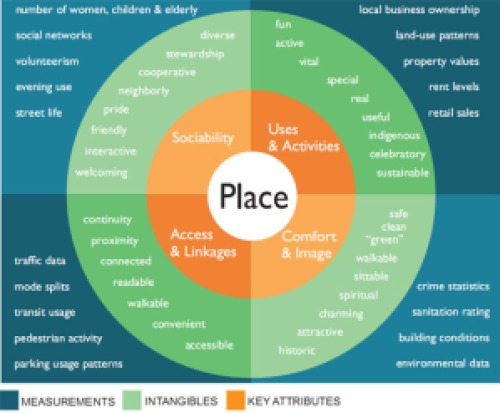A neat one-page summary of what makes a successful plaza, square, shopping strip, or park – the places that communities need to be communities.
http://www.placemakingchicago.com/about/qualities.asp
Chicago’s Metropolitan Planning Council, in an effort called “Project for Public Spaces”, reviewed thousands of public spaces around the world and concluded that successful places share four qualities:
– they are easily accessible;
– they have a mix of uses and activities attracting different ages and interests;
– they are comfortable and have a good image; and,
– they are sociable places, where people meet each other and take people when they come to visit.”
“Imagine the center circle on the diagram is a specific place that you know: a street corner, playground, or plaza outside a building. You can evaluate that place according to four criteria in the orange ring. In the green ring are a number of intuitive or qualitative aspects by which to judge a place; the blue area shows the quantitative aspects that can be measured by statistics or research.”

Les,<div><br></div><div>This is a great model for Placemaking, but the credit should go to the non-profit organization Project for Public Spaces (<a href="http://www.pps.org">www.pps.org</a>), not Chicago's Metropolitan Planning Council. CMPC does deserve credit for partnering with PPS, and recognizing the validity of their research, which is based on the studies of William H. Whyte.</div> <div><br></div><div>Erik<br><br></div>
<html><head></head><body style="word-wrap: break-word; -webkit-nbsp-mode: space; -webkit-line-break: after-white-space; ">Thanks Erik! <div><br></div><div>You prompted me to discover William H. Whyte. PPS has a nice page on this famed urbanist at <a href="http://www.pps.org/reference/wwhyte/">http://www.pps.org/reference/wwhyte/</a> including a collection of quotations (my favourite below).</div><div><br></div><div>His recognition of the importance of having a diversity of activities reminds my of Jane Jacobs’ writing about different flows of people (young/old, workers/parents/joggers etc…) occupying a public park at their own special times of day, making it a permanently inhabited space. Have you read The Death and Life of Great American Cities? I read it while living in SanDiego for a few weeks in 2009 and found it tremendously moving. Seeing the different flows of people travelling to Petco Park, out shopping, rushing to and from work, or cruising the GasLamp, as well as the tidal movements of the homeless, brought the idea to life.</div><div><br></div><div>Best wishes – Les</div><div><br></div><div><span class="Apple-style-span" style="font-family: Helvetica, arial; font-size: 14px; color: rgb(51, 51, 51); line-height: 24px; ">???We are not hapless beings caught in the grip of forces we can do little about, and wholesale damnations of our society only lend a further mystique to organization. Organization has been made by man; it can be changed by man.??? - </span>William H. Whyte</div><div><br></div><div><br></div><div><div><div></div></div></div></body></html>